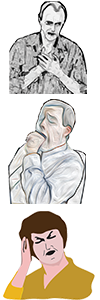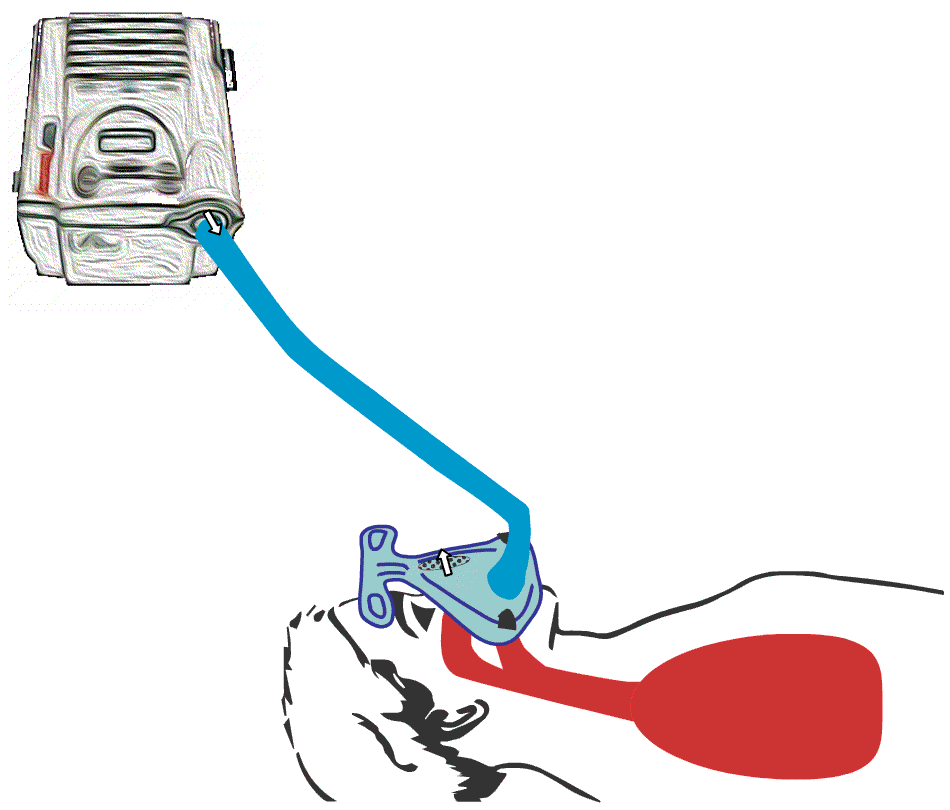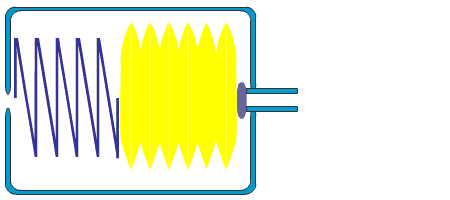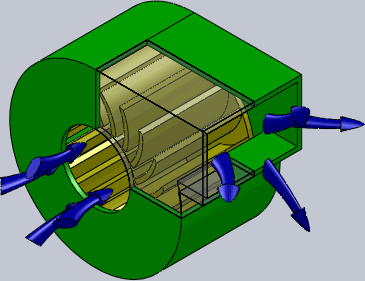Module 2: Breathing with
Ventilatory support
In this chapter you will learn about:
- normal breathing;
- chronic respiratory failure;
- who will benefit from using a breathing machine;
- the types of machines available and how they work;
- general principles on how they are used and maintained, and the required follow-up.
Normal breathing
The blood in the lungs takes up oxygen and gets rid of carbon dioxide. This gas exchange occurs in tiny airs sacs within the lungs called alveoli, which constantly receive new air and expel the used air when we breathe. Thin blood capillaries are in close contact with the air in the alveoli and gases can penetrate through the wall of the thin sacs. The body’s metabolism needs oxygen and the waste gas of the metabolic process is carbon dioxide.
Oxygen binds to the red blood cells and carbon dioxide is dissolved in the blood. In order for these gases to maintain a normal balance in the body, for example, to enable the nervous system to control the activity of the respiratory muscles in the normal way, we depend on many factors. The muscles must also be strong enough, so we can take deep breaths, and the chest and spine must not be stiff and hinder the respiratory muscles from passing enough air down into the lungs. In addition, the lungs and airways must not be damaged in a way that makes it difficult for oxygen to be taken up and carbon dioxide removed.
Respiratory failure
Many chronic respiratory failure patients, who need help with home mechanical ventilation have healthy lungs, but at the same time a respiratory muscle disease or damaged nervous system that leads to the paralysis of such muscles. The body’s ability to pump air in and out of the lungs is damaged, but when the air passes down into the lungs it is used in the normal way. Consequently, weaker breathing leads to an abnormally high amount of carbon dioxide in the blood and an abnormally low amount of oxygen. The medical term for this type of respiratory failure is low ventilation or hypoventilation. We breathe less and poorer when we are asleep than when awake. The respiratory muscles must work harder, they become tense and never get to rest before having to deal with the activities of the next day. Respiratory failure is therefore worse at night and, in many cases, this explains the initial symptoms of hypoventilation and the fact that many patients only need respiratory support during the night.
Potential symptoms of respiratory failure:
- Frequently disturbed sleep during the night, restless sleep.
- Sleepiness during the day.
- Tiredness after sleeping.
- Fatigue
- Reduced concentration
- Morning headaches
- Heavy breathing whilst resting or during exertion.
- Heavy breathing when lying flat on one’s back.
- Frequent airway infections
- Loss of appetite
- Weakness
- Loss of weight

The consequences of respiratory failure could be the feeling of being under the weather, exhaustion and morning headaches. One often feels tired and sleepy during the day, especially in situations with monotone activities, such as reading, watching TV, driving, etc. In such situations, it is not uncommon to fall asleep. The ability to concentrate, learn and memorise can become impaired, and one can feel depressed and indifferent. Some people may notice reduced physical performance and others rapid breathlessness on exertion. Decreased appetite may also occur.
When coughing muscles, like the abdomen, are weak, mucus builds up in the airways. The mucus is a breeding ground for bacteria; therefore it is easy to contract infections, such as bronchitis and pneumonia. These airway infections cause the respiratory muscles to work even harder and can cause sudden (acute) severe respiratory failure, which can be fatal if not treated correctly and in time.
Respiratory failure often develops slowly over time, consequently it is easy to overlook. Occasionally, family or friends are the first to notice changes in performance or behavour, for example, if one seems more easily tired, sleepy or forgetful.
How is respiratory failure detected?
People with disorders that could lead to hypoventilation should be offered regular check-ups with a pulmonologist. When symptoms appear, a doctor’s check-up along with any supplementary investigations of breathing during asleep, can confirm whether or not there is a problem and what can be done. In addition to one’s medical history and symptoms, investigations can be carried out to measure oxygen and carbon dioxide in the blood during the day or night. The volume of the lungs and the strength of the respiratory muscles are measured during the initial investigation. Some investigations need to be performed at the hospital others can be done at home with transportable equipment.
Who can benefit from the therapy?
People with muscle weakness and neurological diseases that affect the respiratory muscles can develop respiratory failure and therefore require help to relieve inspiratory muscles. A stiff chest or severely skewed spine can also lead to respiratory failure. The work involved with sucking air into the lungs becomes an overburden. The muscles are unable to maintain normal levels of ventilation. Some patients with severe obesity can develop respiratory failure, partly because the respiratory muscles become too weak and partly because the respiratory centre that controls respiratory activity functions abnormally. The primary damage in some patients is found in the respiratory centre, which disturbs the regulation of breathing. Consequently, they will need therapy.
What types of breathing machines are available?
We can treat diseases that lead to chronic respiratory failure with hypoventilation and uncomfortable symptoms, with mechanical respiratory assistance. In modern terminology, the collective term is long-term ventilation support. This includes both advanced breathing machines, usually called ventilators, and simpler BiPAP machines. Both are mechanical air pumps that help the respiratory muscles by pressing air down into the lungs via the airways. The air goes from the pump through a hose to the user. In most cases, the hose is connected to a mask that either covers the nose or both the nose and mouth. Occasionally, some patients may use an invasive device, a plastic tube (tracheostomy cannula) instead of a mask. The cannula enters directly through the skin into the windpipe. The opening is made surgically, a so called tracheostomy (see later chapter).
Ventilators and BiPAP machines: Mechanical air pumps
Animated illustration of how a BiPAP machine works. BiPAP presses air down into the lungs and creates deeper aspirations for the user.

Animated illustration of how a BiPAP machine works. BiPAP presses air down into the lungs and the pressure changes the deepness of breathing in the lungs.

Animated illustration of how the first ventilators had a bellows that pressed air into the tube.

Animated illustration of how turbines now create the air flow in all machines.
List of definitions
- Respirator - ‘re’ - ‘spira’ = ‘a person who rebreathes’ - an advanced breathing machine approved for patients who require around the clock respiratory assistance (a-life-sustaining ventilator).
- Ventilator - ‘vent’ - wind + ‘tor’ = ‘to blow out’ - synonym of respirator and the term that is more commonly used abroad (hyperlink to the ventilator tab).
BiPAP = Bi-level Positive Airway Pressure. This is a simpler breathing machine that is generally used by patients who do not need around the clock respiratory assistance.
 Illustrations of different types of BiPAP machines.
Illustrations of different types of BiPAP machines.How will respiratory support affect me?
A BiPAP machine or ventilator can wholly or partially replace the work of the respiratory muscles. This relieves weak and over-exerted respiratory muscles. The lungs can inhale deeper with less accumulation of mucus. Thus, it is easier to avoid infections. Oxygen and carbon dioxide levels in the body become more normal. The quality of sleep improves and one becomes more alert and awake during the day. Daily living improves even during the periods when respiratory assistance might not be required. One gains more energy and is able to perform better.